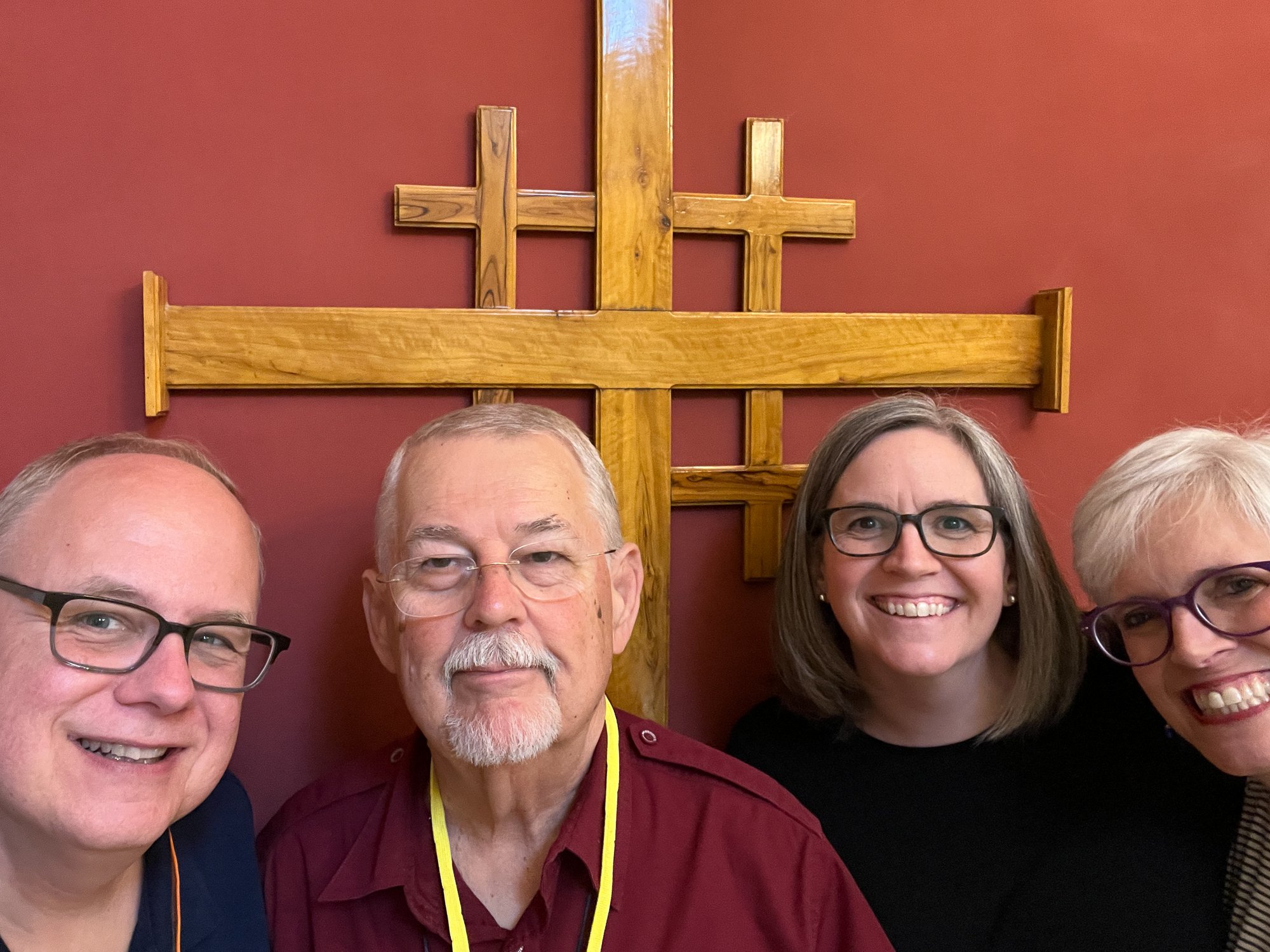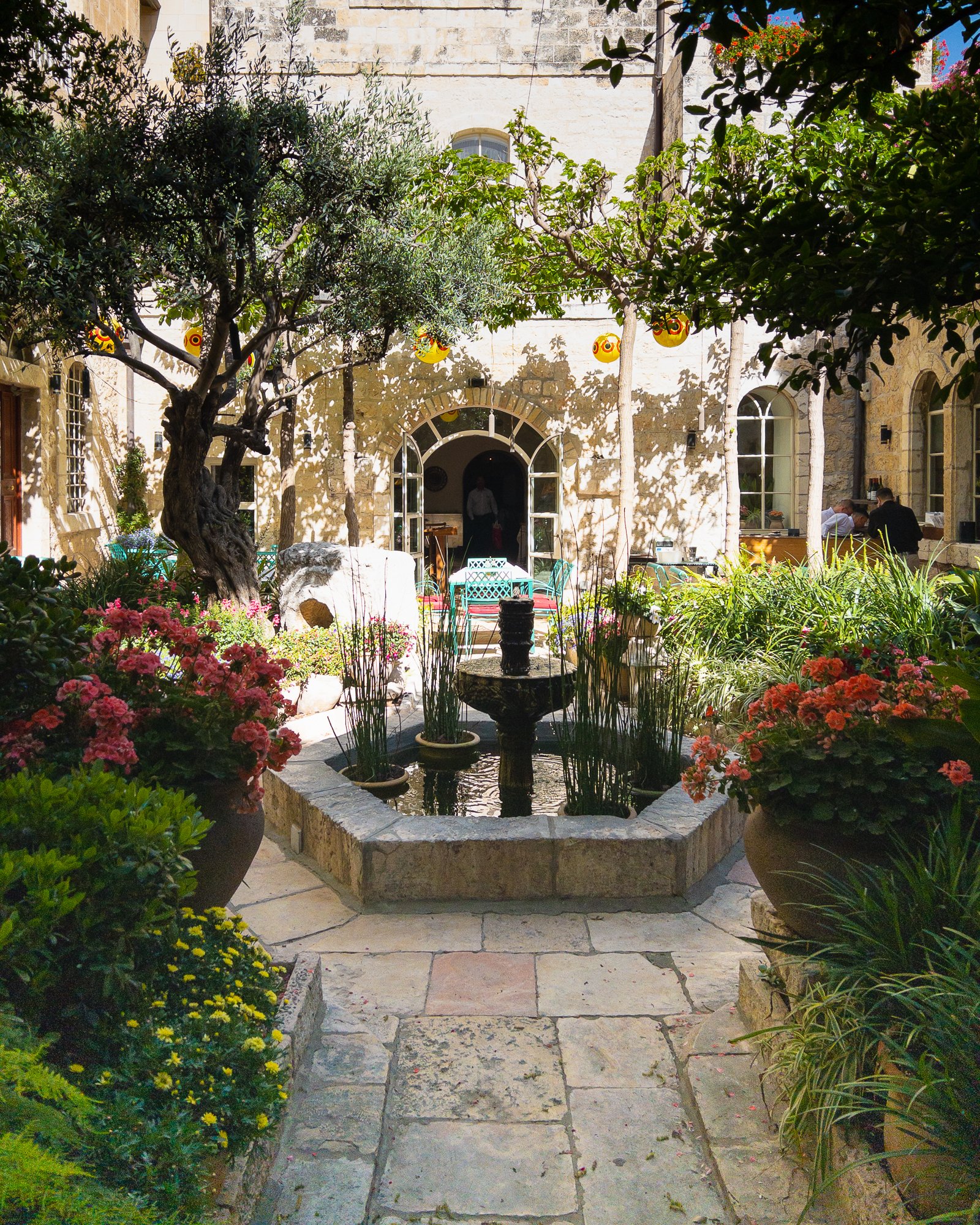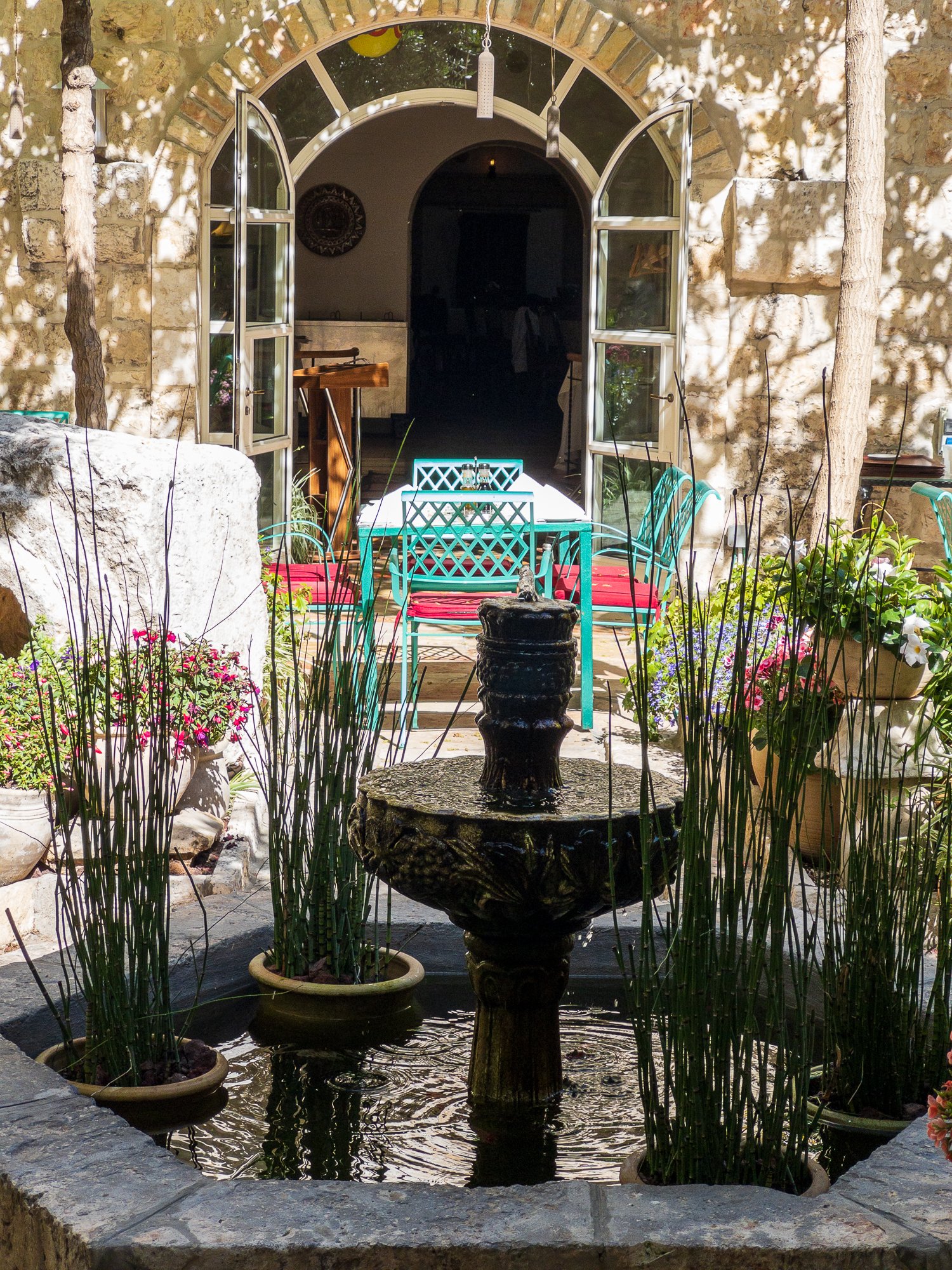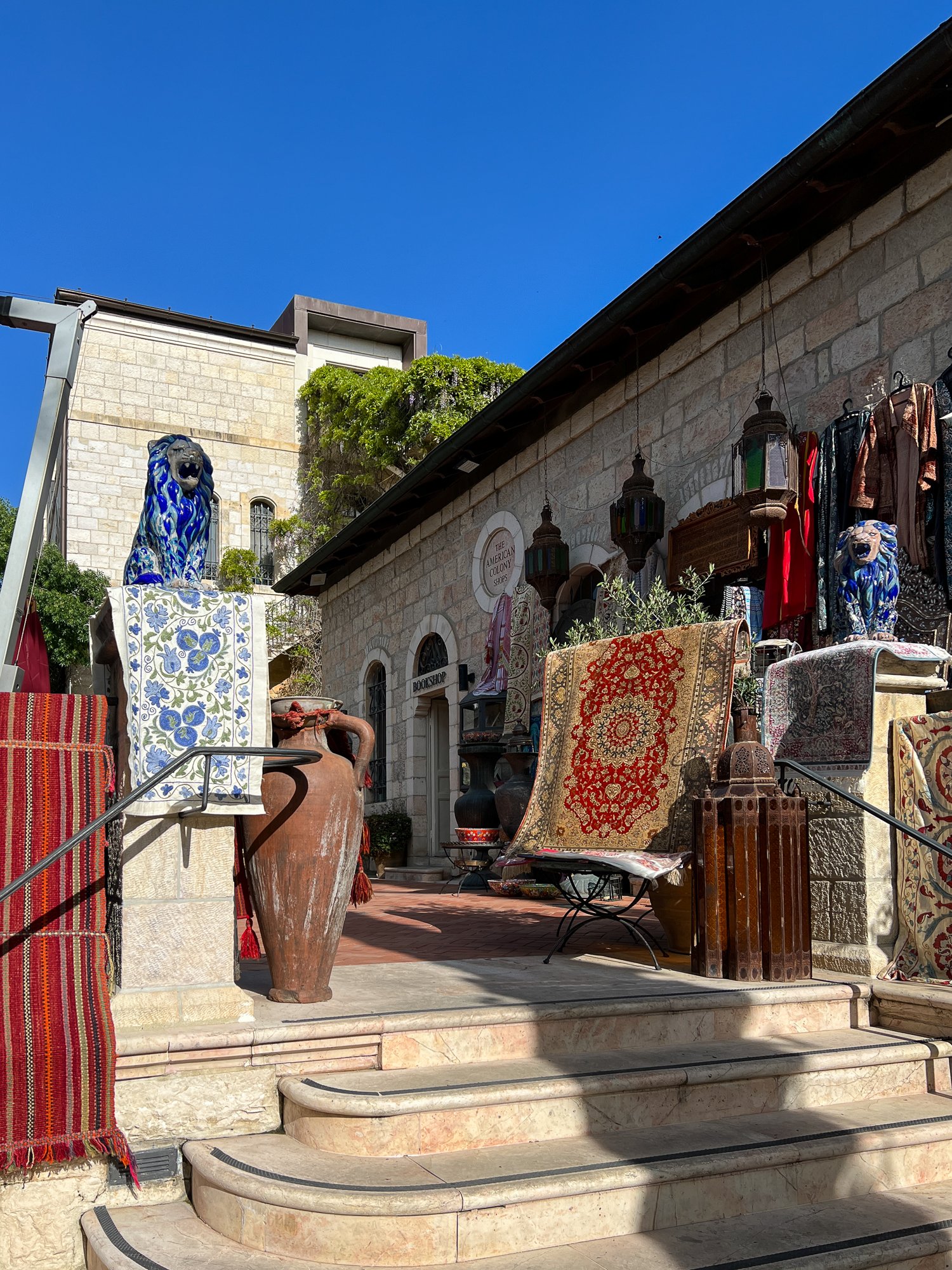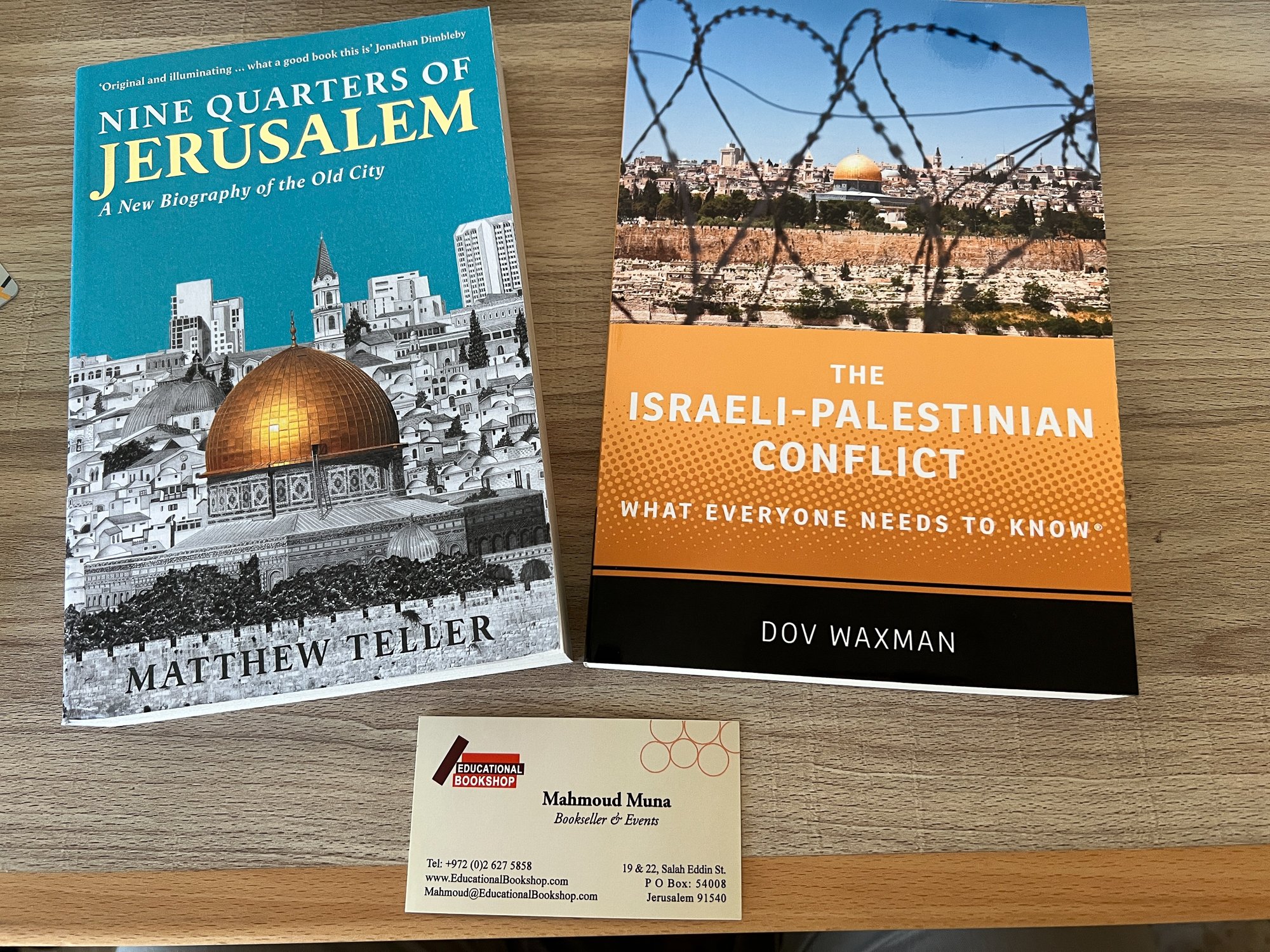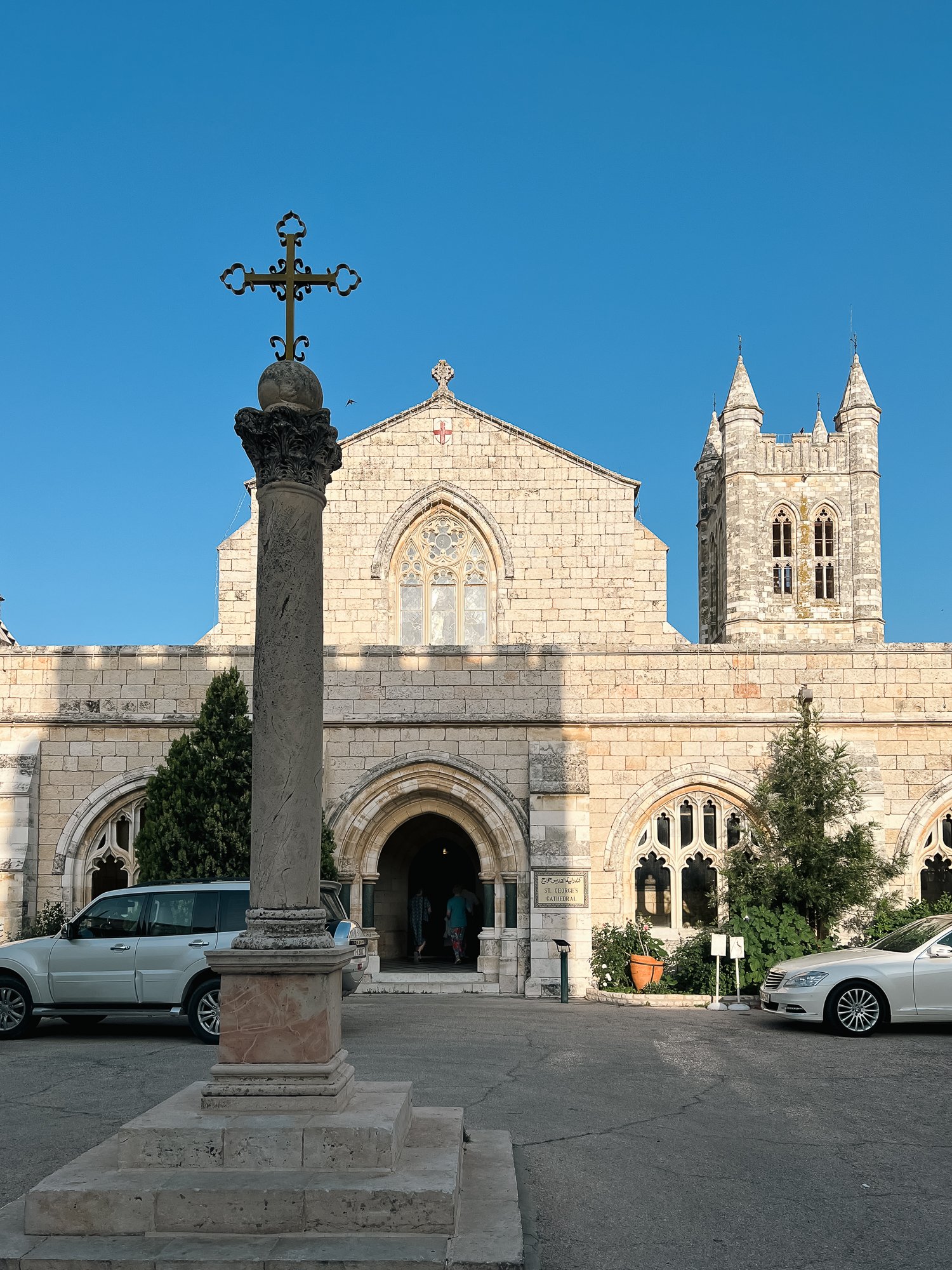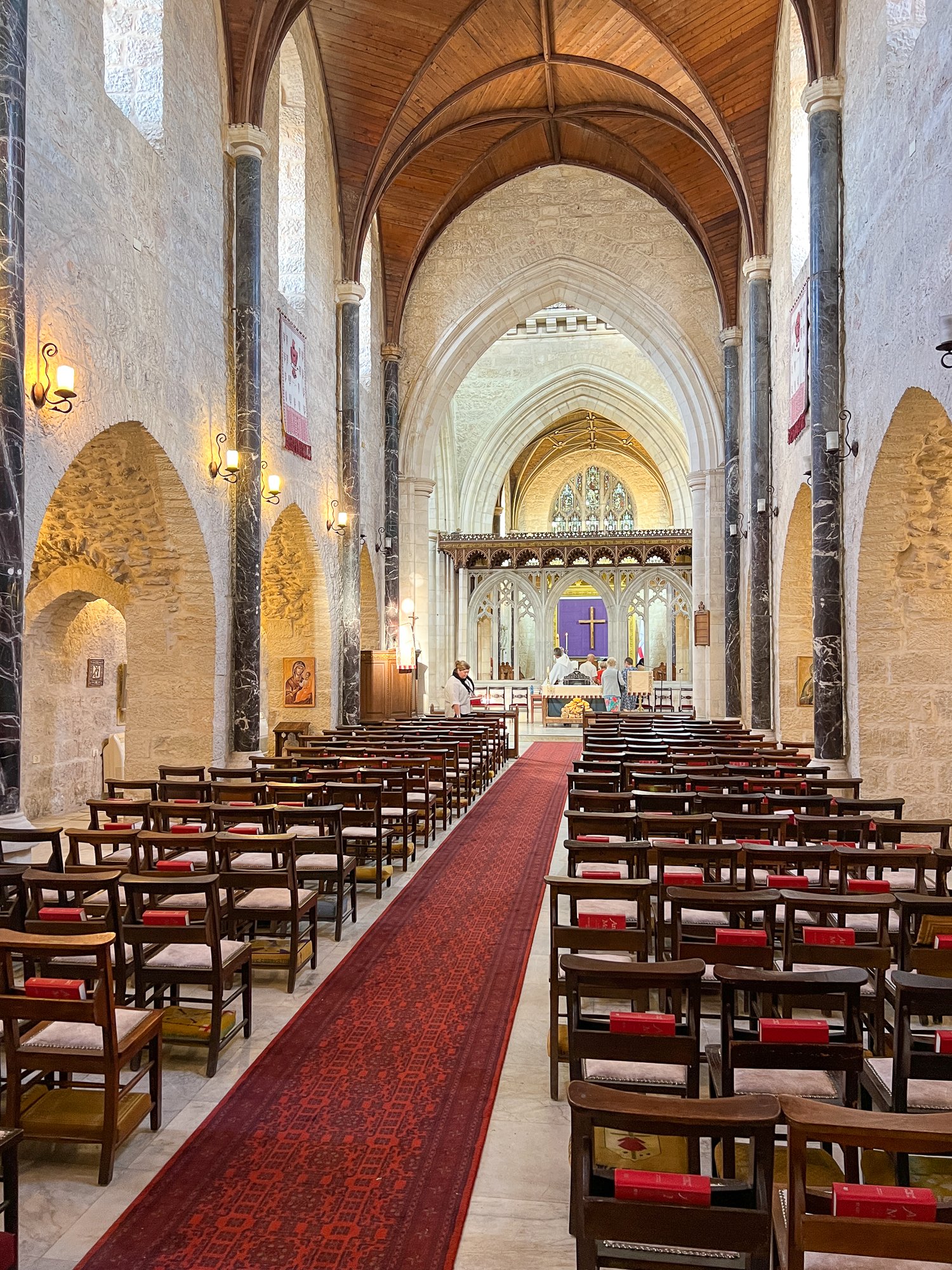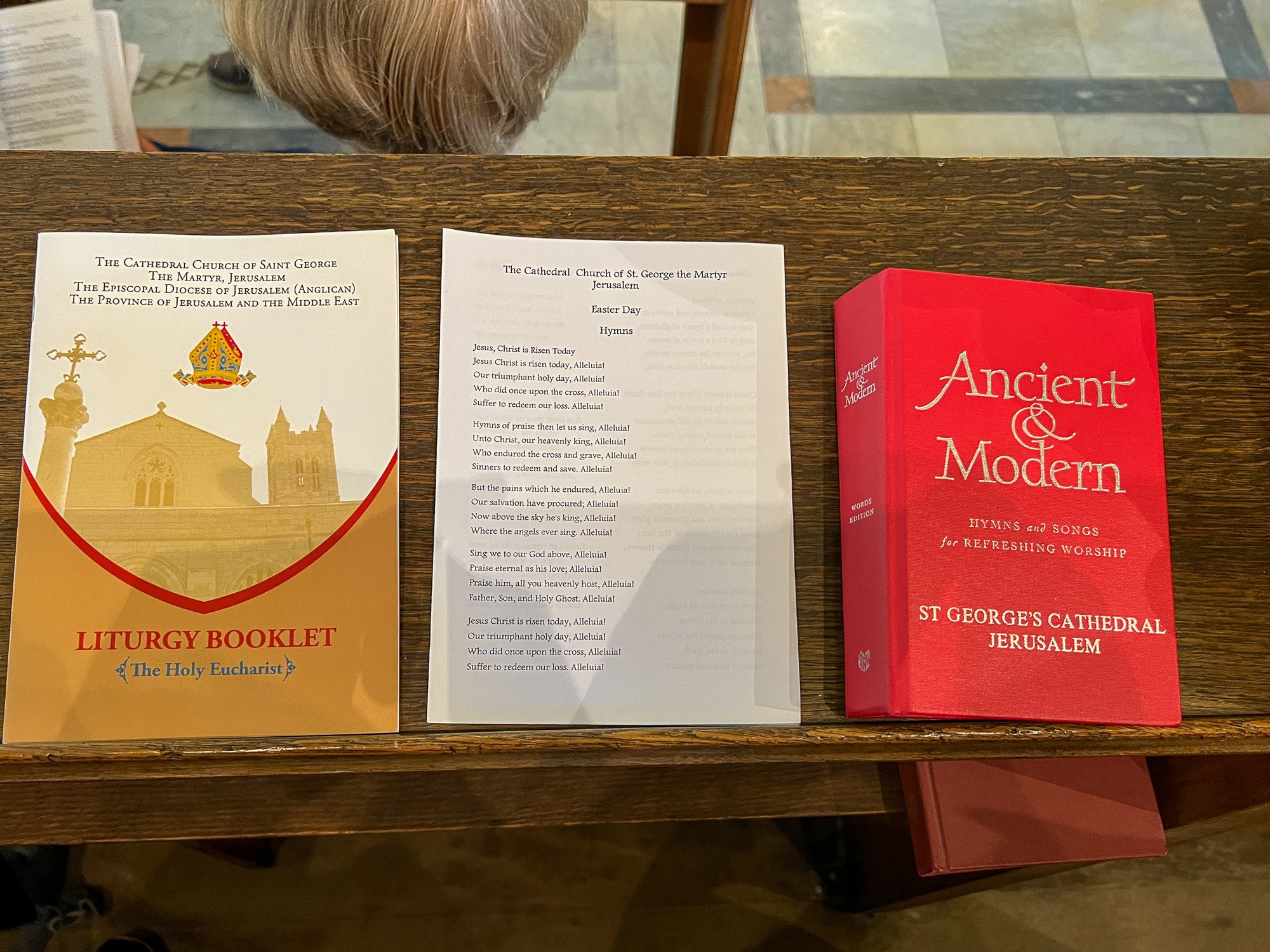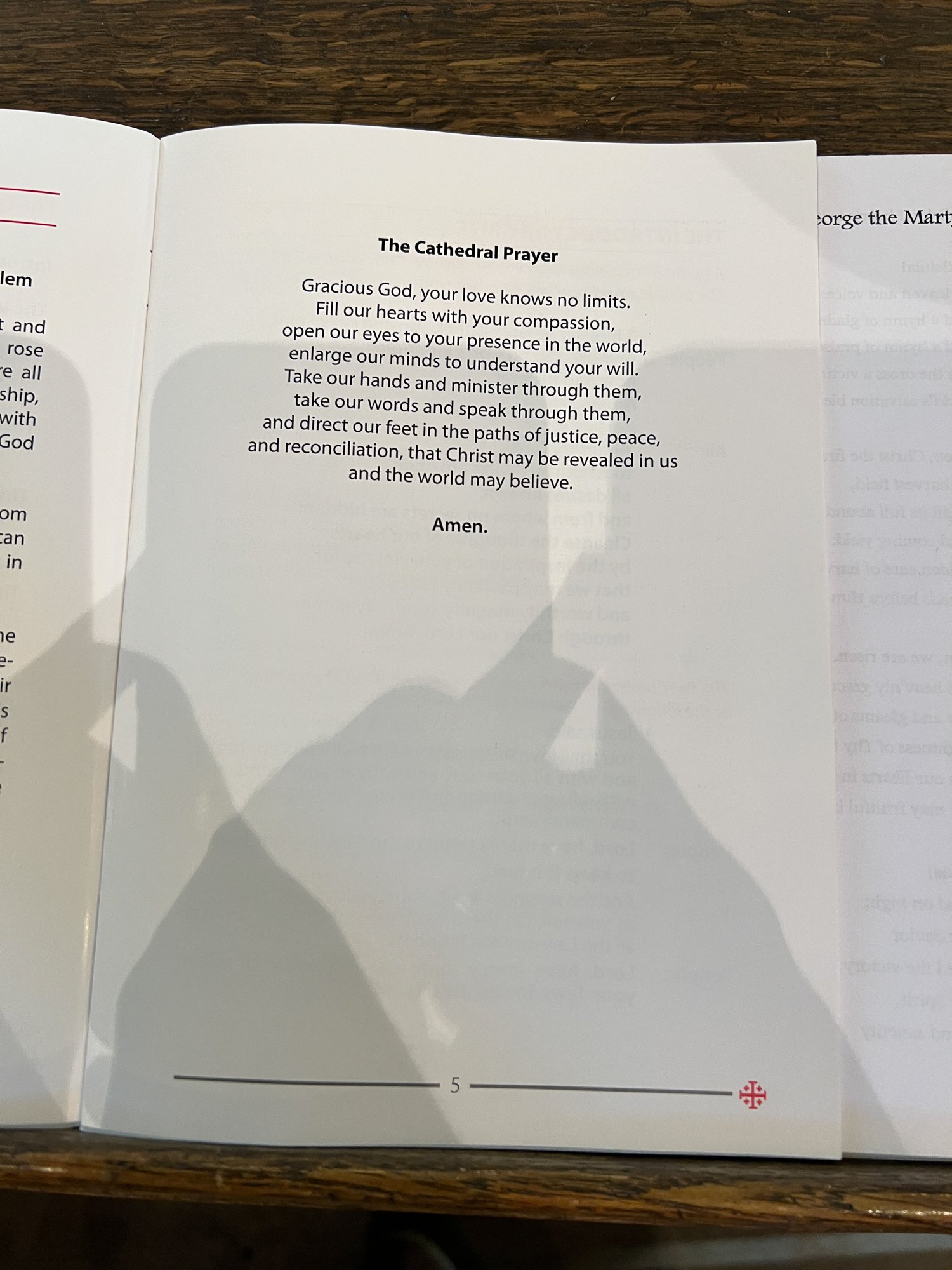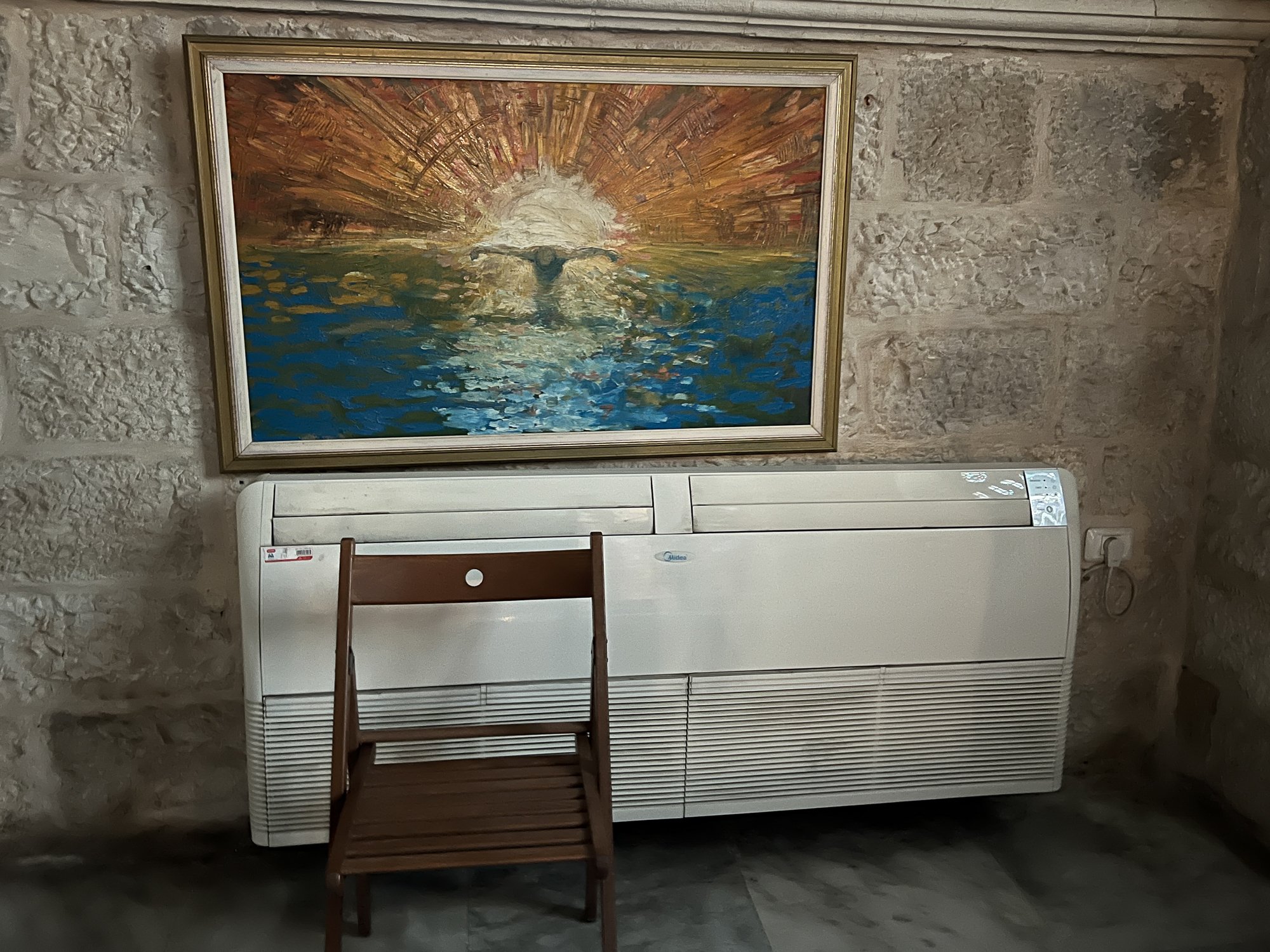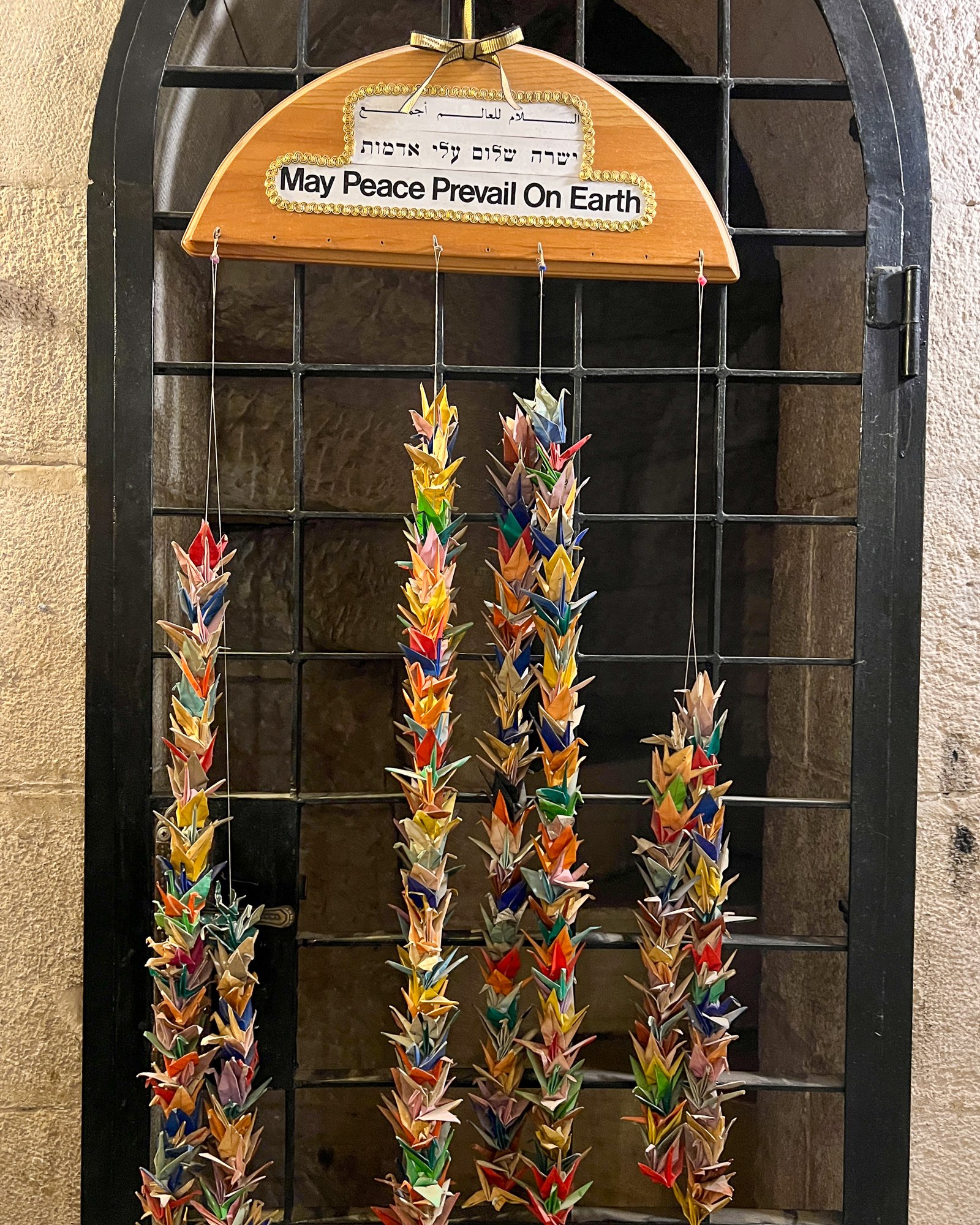After being on the go, we had a light day. Thinking checkout time was 11, we got all packed up for the move to Saint Geroge’s College. For Friends fans, we were channeling Ross who would stay in his hotel room until the last possible moment to get every penny’s worth. As we lounged in the hotel lobby enjoying fresh juice, we were asked if we could be more comfortable in our rooms since checkout time was Noon. D’oh! Apparently we were channeling Homer Simpson.
Leslie and Loren had made friends with the taxi driver to Jaffa, so they arranged transfers for us to Saint George’s. It really was a walkable distance, but Jerusalem is hilly and we have luggage, so a taxi made sense. He had to make two trips, so we were the first to go to give Leslie and Loren some more time.
Here’s a little bit of Jerusalem cultural geography. Officially, Jerusalem is divided into East and West Jerusalem. For the world, West Jerusalem is Israeli and East Jerusalem is occupied Palestinian territory. For Israel, Jerusalem is united. Well, sort of. Public transportation stops at the Green line. Israeli buses don’t go into East Jerusalem. Palestinian buses don’t go into West Jerusalem. For the pedestrian, all one notices is a change from Hebrew dominant to Arab dominant language and culture.
After dropping us off, our driver returned for Leslie and Loren so we were the first to get settled. The Saint George’s campus is kind of like Saint Peter’s, with different points of access and different purposes. The Cathedral, seat of the Anglican Archbishop in Jerusalem and, now, Archbishop of the Episcopal Church in Jerusalem and the Middle East, is the center of the campus. The Archbishop’s residence and diocesan offices are next to the Cathedral. The college with its dorm is on one side and a very nice St. George’s Guest House is on the other. Well landscaped gardens create an urban oasis tying the campus together.
A bit of diocesan connections. Archbishop Naoum is good friends with our Bishop-elect, Sally French, and is very committed to uplifting women's ministries in the province.
The neighborhood is mostly Palestinian shops, educational institutions, and homes with some hotels going back a century or more. I had to note the irony of the massive Israeli Justice Department complex next door in territory recognized as occupied by the rest of the world, with an Israeli district court across the street. It must create similar feelings that Roman occupying institutions in Jewish territory sparked in Jesus’ day. The difference here is that both parties have historical connections with the land and neither is an outside occupying force, although elements of both sides see each other in just that way. In this particular area of Jerusalem, like much of Jerusalem outside the Old City, history only goes back a few hundred years. Palestinians do have the older land claims in East Jerusalem since their homes and businesses were here before the Jewish immigration increased in the late 19th century.
Back to our oasis. Armenian tile work is everywhere, reminding us of how Armenian craftsman came to Jerusalem in the early 20th century to flee the genocide and became an established part of the community. The college is a collection of offices, dorm rooms, a significant library, and a couple of meeting rooms. The dorm rooms are quite spacious, with plenty of storage, but they are just like a college dorm room - tile floor, IKEA style furniture, twin beds, but also an en-suite bath. Each room is named after a moment in the life of Jesus or the surrounding geography. Leslie and Loren stayed in the “Baptism of Jesus” guest room, and we stayed in “Mt. Tabor,” the traditional site of the Transfiguration. Armenian tile plaques identified each room, as well as the person, church, or diocese that sponsored its refurbishment. Many US dioceses have shown strong support for Saint George’s College!
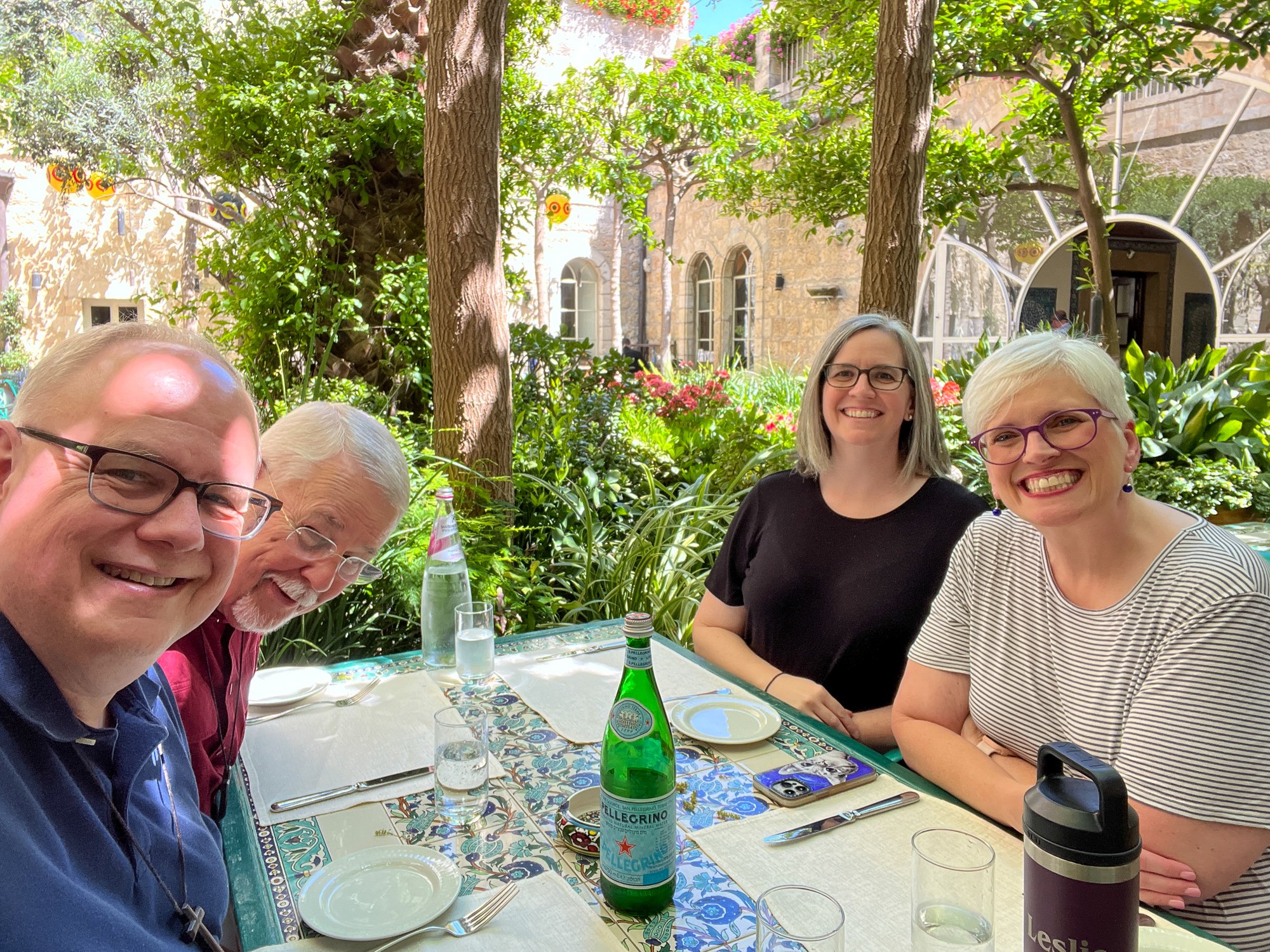
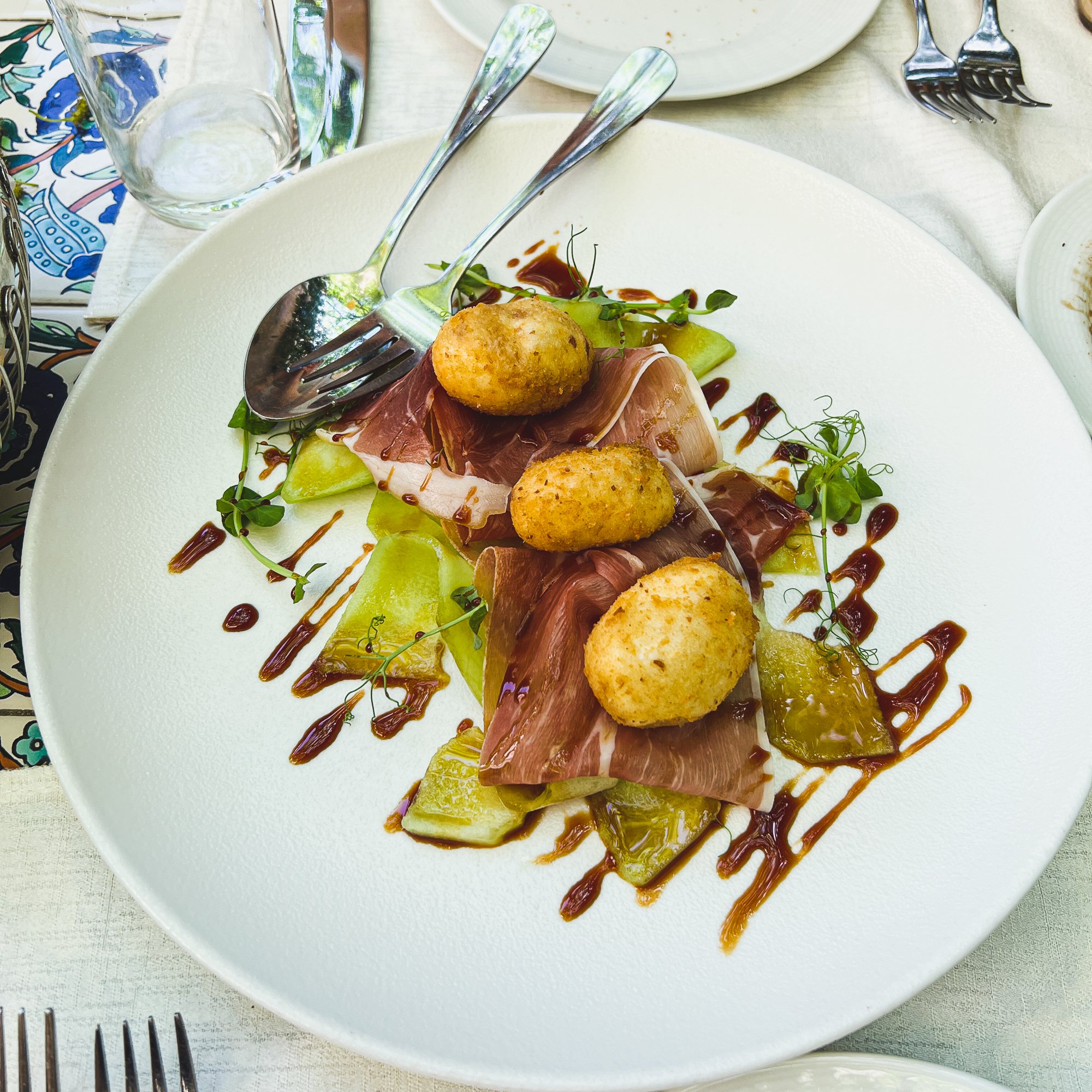
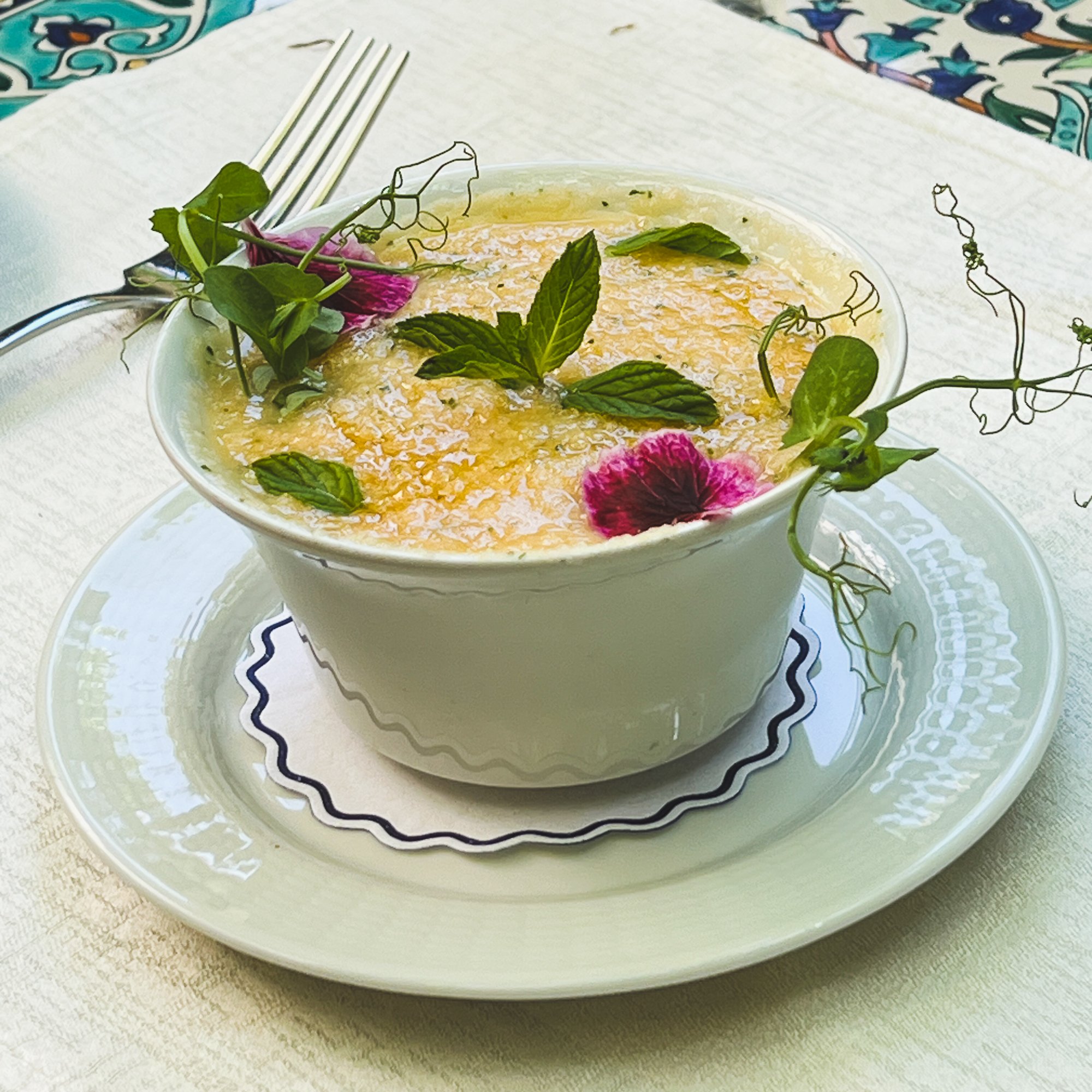
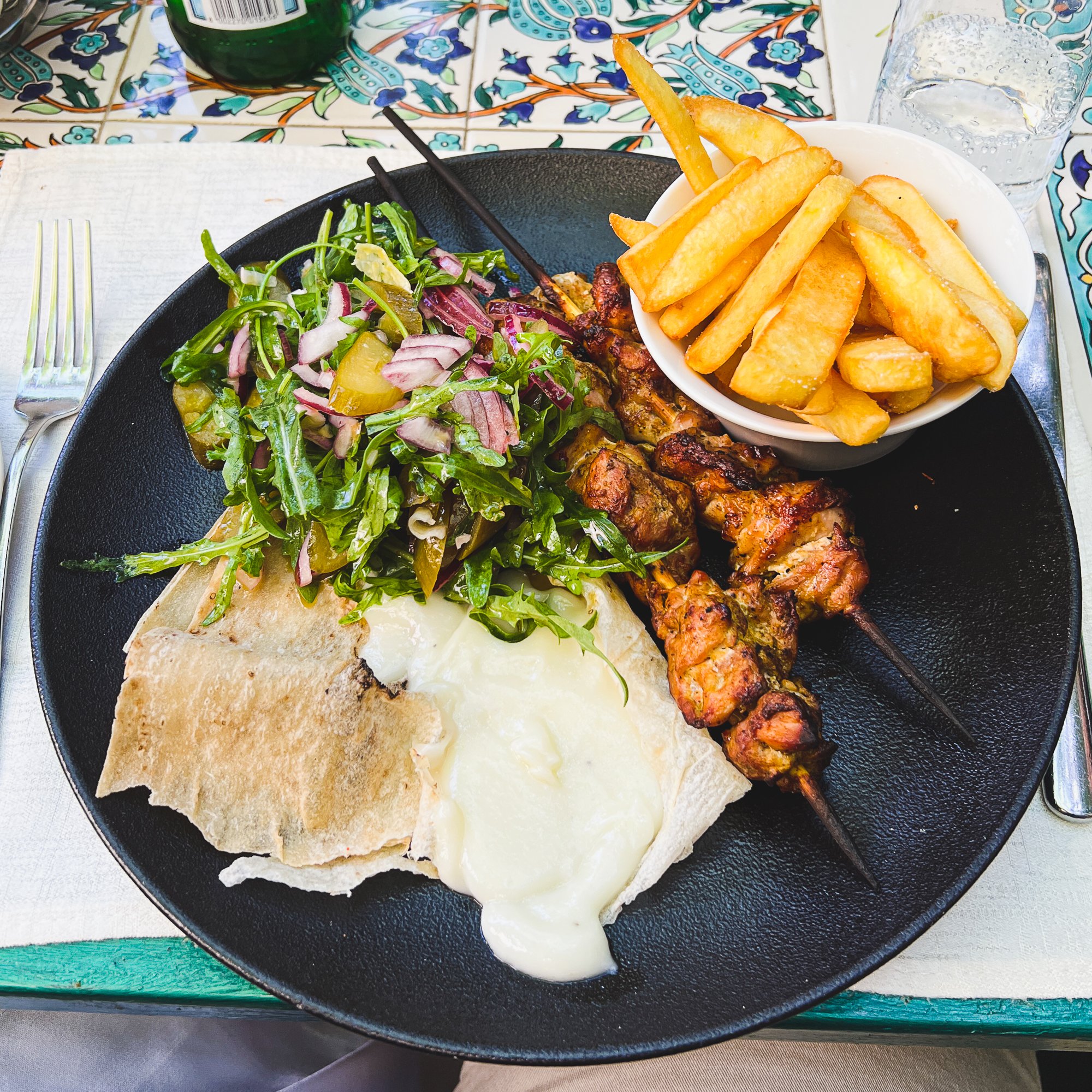
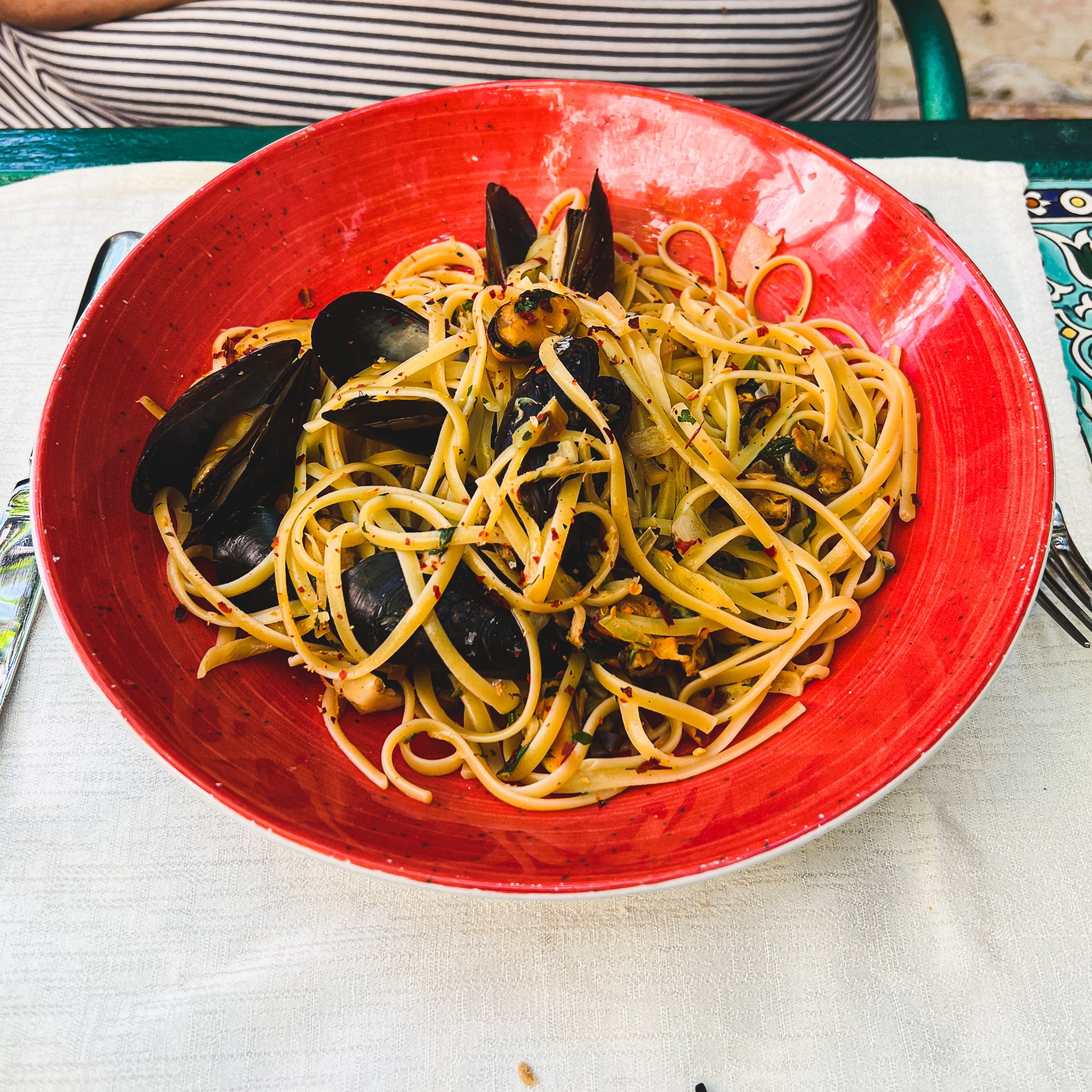
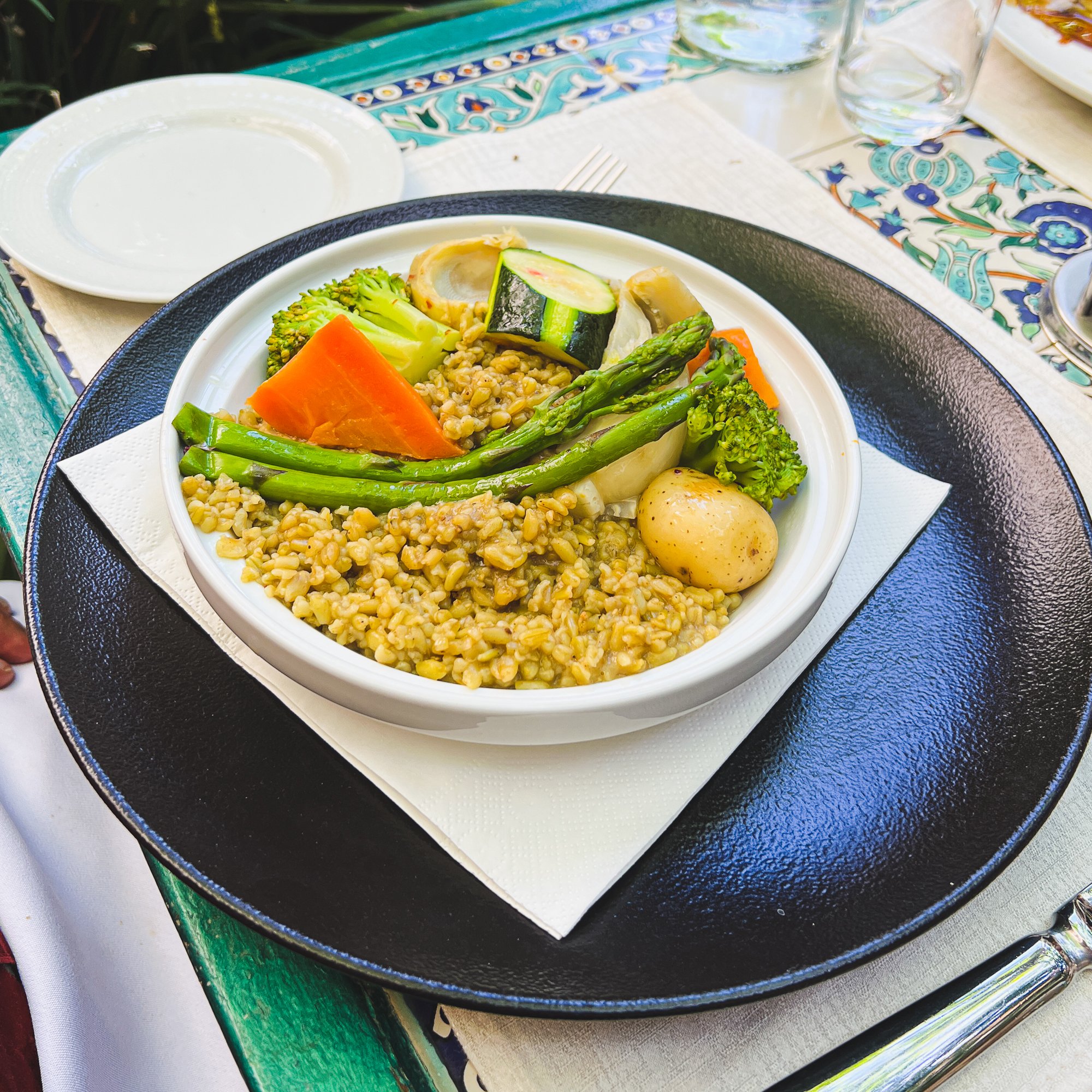
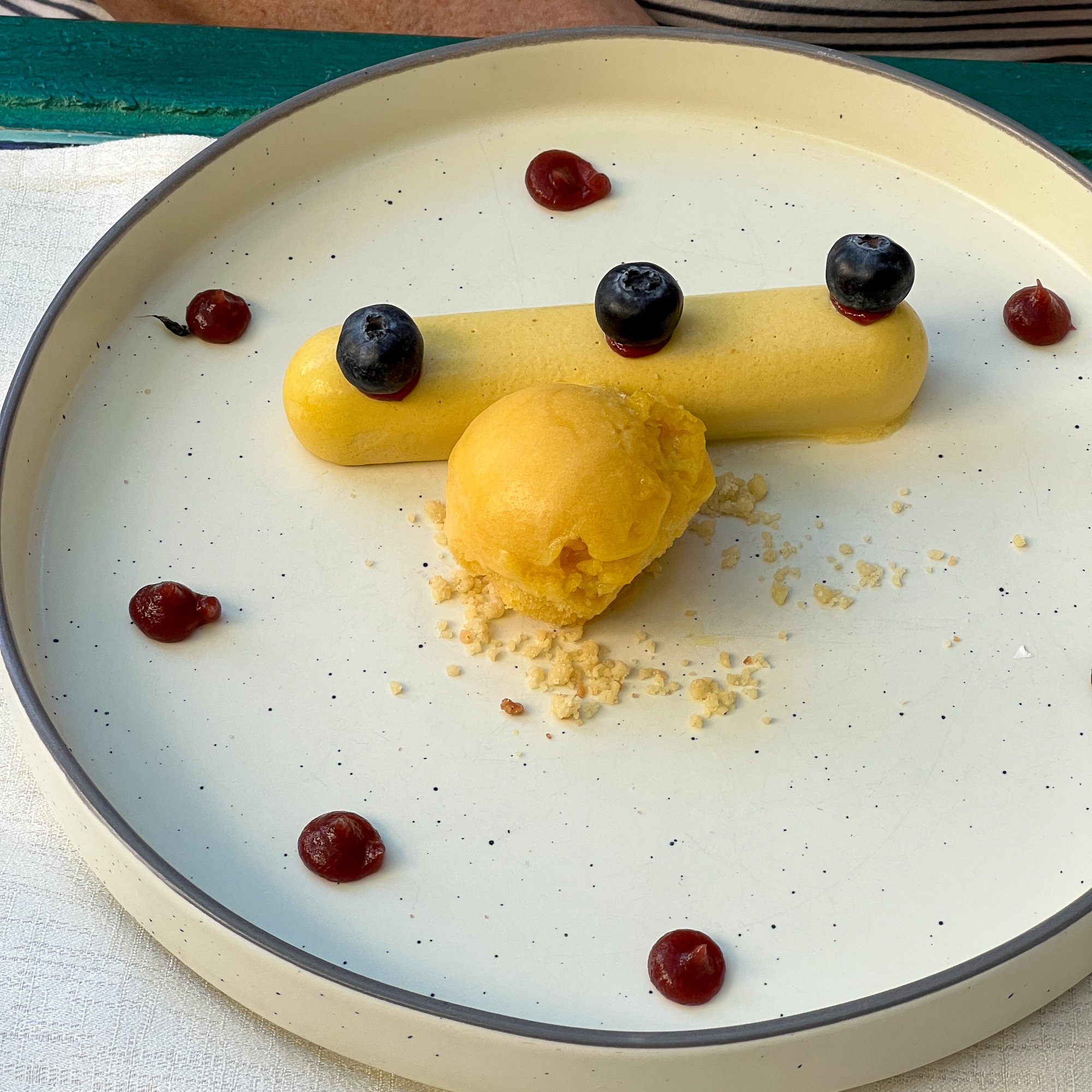
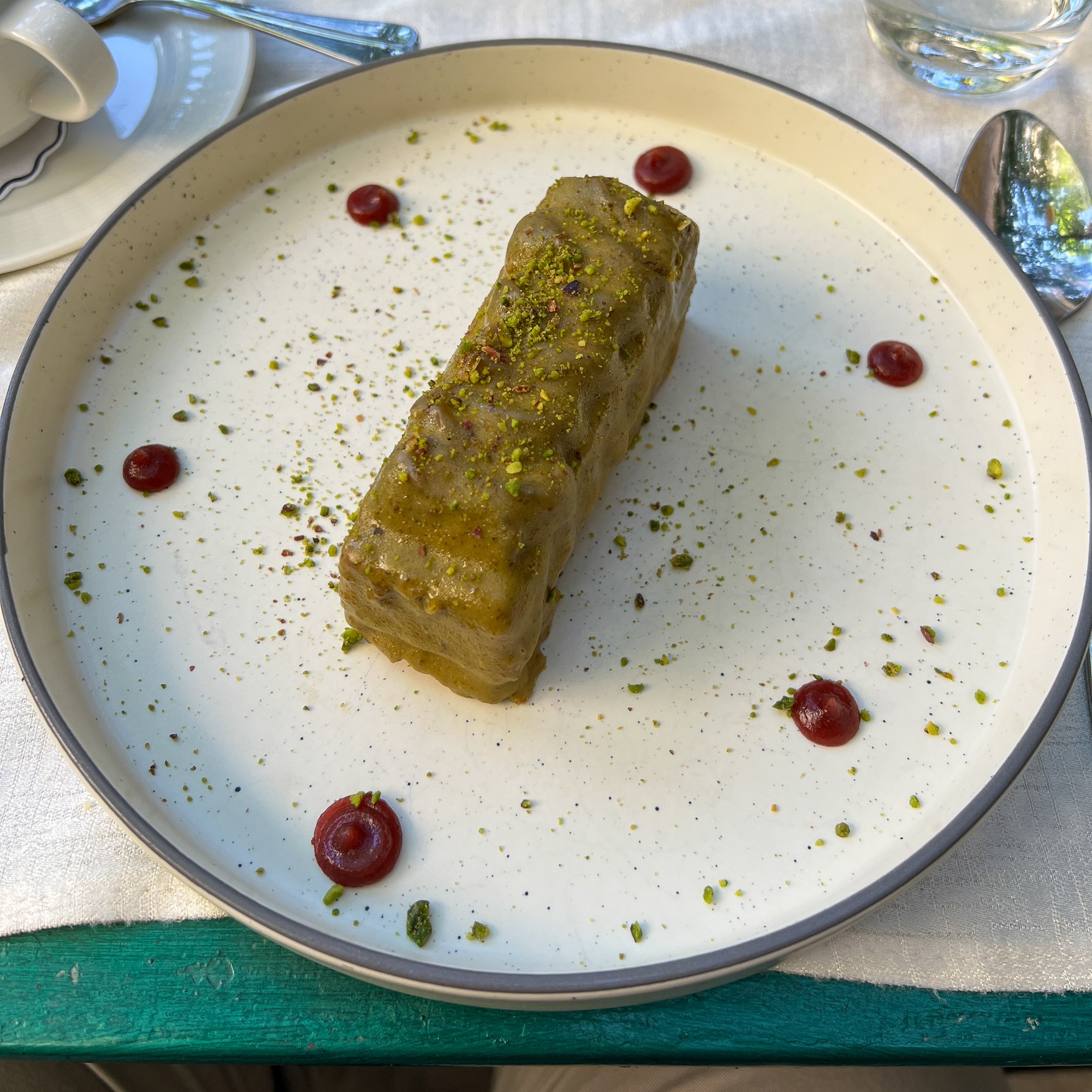
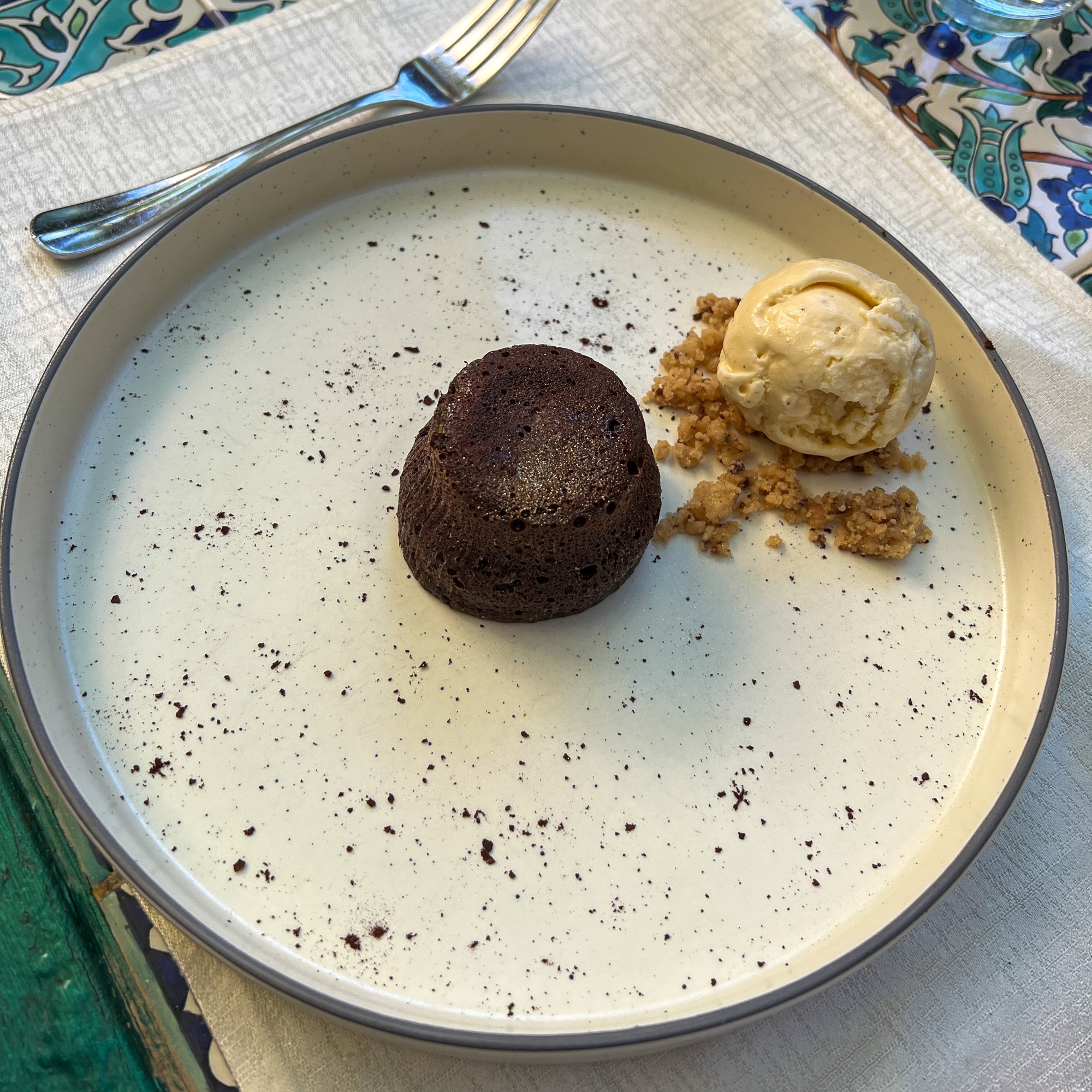
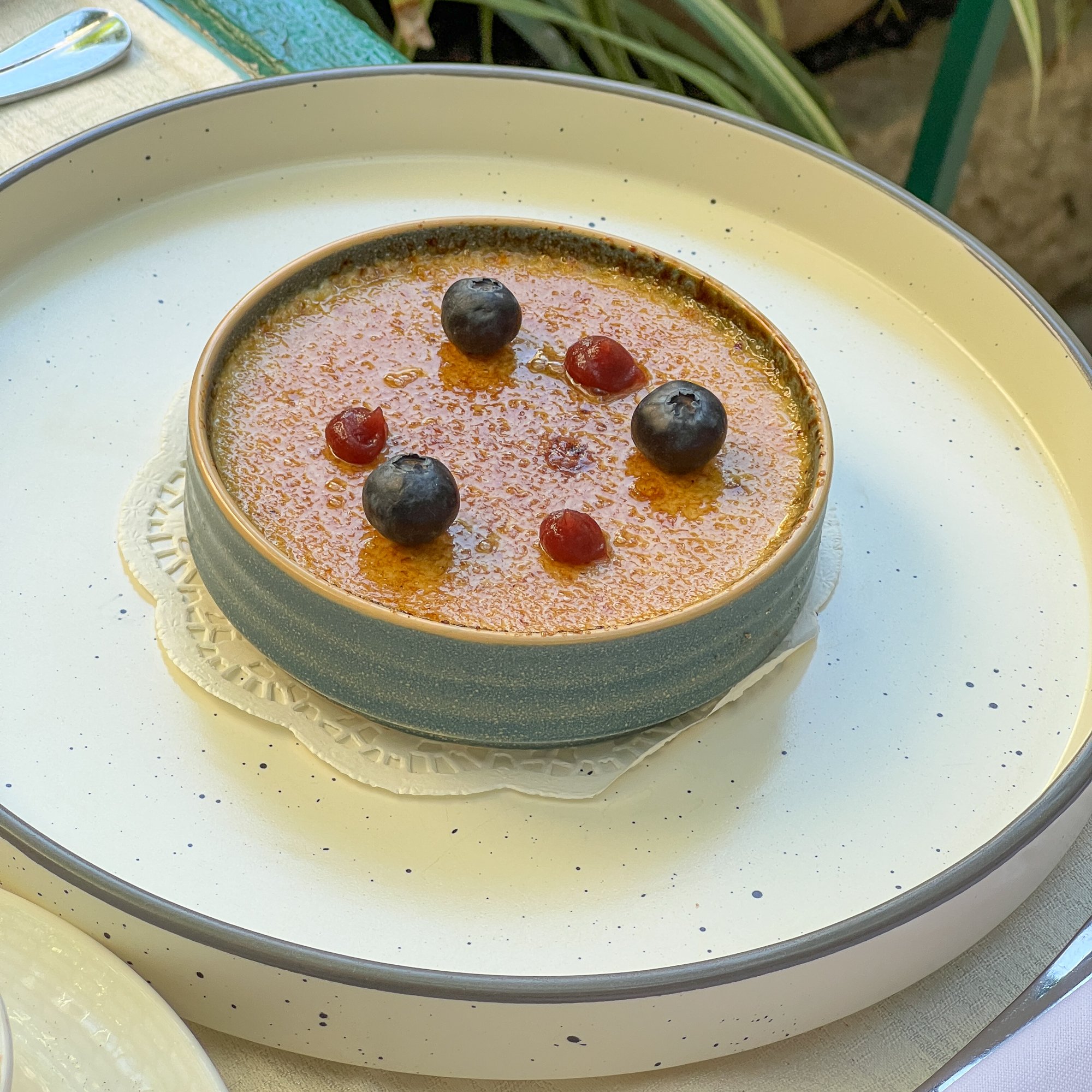
Once we were settled, it was time for a late lunch. We headed down the street to a famous pilgrim hotel, the American Colony. The hotel has a fascinating history. The building was originally a harem for the Turkish Pasha’s four wives. It was then purchased by the Spafford’s, an American family, who set it up as an hotel and oasis for American pilgrims. They family still own the hotel, but it is professionally run by a management company with the same mission.
We enjoyed a relaxed lunch in a beautiful courtyard. After our meal, we checked out shops in an out-building, including a bookstore. It turns out that bookstore is an adjunct of the Educational Bookshop near the college. Mahmoud, the manager, and his brother are well known for moderate Palestinian education and activism and work closely with the college. We wanted to learn more about Jerusalem and the modern Palestinian/Israeli conflict so Mahmoud recommended a few titles that would stay focused on facts rather than interpretation.
I picked up Nine Quarters of Jerusalem: a new Biography of an Old City by Matthew Teller, which tells the story of the Old City through its nine gates. Traditionally, Jerusalem is thought to have four quarters - Christian, Armenian (who are also Christian), Muslim, and Jewish. However, those four quarters are an English invention from the 19th century, as the Old City is much more diverse and intermingled than that. This book tells the story of the Old City through its various entry points. While Teller’s history is spot-on, he admits he is biased. Part of his goal is to skewer the prevailing assumptions we have in the West and see the historical picture more inclusively. Available on Amazon, too.
My others find was The Israeli-Palestinian Conflict: What Everyone needs to Know, by Don Waxman. This book lays out the issues from both Palestinian and Israeli perspectives in Q&A format from the historical origins of the nationalist movements in the Nineteenth Century through today. Also available on Amazon.
Loren picked up the Lemon Tree, a look at the conflict through the eyes of two families, one Palestinian and one Israeli Jewish who occupied his house, who maintain a decades long relationship throughout the regions modern history. Also on Amazon.
Mahmoud had quite a back story. He grew up in East Jerusalem, which is a good things, so he could live here. He wanted to go to a Jerusalem college to study engineering but could not because the program required an honorable discharge from the Israeli military, which Palestinians do not want to and cannot serve in. This is just one of the many ways in which some doors are closed to some but open to others.
We asked his opinion on the best way forward. He was clear that both Israelis and Palestinians are here and neither are going away. His personal opinion is that a two-state solution is not viable. The only way to truly safeguard everybody’s rights, he believes, is to have one secular state with a strong Constitution guaranteeing rights and freedoms for all parties. It became clear to us just how hard a solution would be to find, and that someone who does not live in the region really cannot fully appreciate how complex, and yet how basic, the conflict is.
I asked him about Archbishop Desmond Tutu’s criticism of Israel for becoming an apartheid state. He did not like that term because he did not find it helpful in advancing the conversation. He also said the reality is that Israel is more “apartheid-like” than “apartheid.” It is a different conflict. He is interested in finding solutions. Not in antagonizing.
The most important thing we could do, Mahmoud said, would be to learn, share what we learn, and not be part of the problem. We would hear similar advice from an Israeli Jewish woman who immigrated from the US in the 1970s and is now part of a group building bridges between Israelis and Palestinians.
We returned to the college for the opening Eucharist in the Cathedral. Our Chaplain, Ken, was celebrant, and the Dean Sewell preached. His sermon caught me when he quoted a British author who spoke of the many compulsions that bring people to church. He compared that to our forming as one community of pilgrims for these two weeks. We each come with different backgrounds, different questions, different reasons - different compulsions - but together make up one community. We each also find God present to us in different ways. It opened me up to how Christ is truly to present to all people in all ways in their own journeys. I don’t need you to have my experience of Jesus. I want you to have your experience of Jesus. We are each on different journeys, but we are on different journey together. That is Christian community.
It made me think of how the Cathedral of St. John the Divine in New York would echoing Saint Augustine in inviting people to Communion: come as you are, leave as God intends you to be.
Much of the music came from the Episcopal Hymnal or the English Hymns Ancient & Modern, and the liturgy was drew heavily from the US and England. I’m always moved by how the US 1979 Book of Common Prayer influenced other prayer book reforms around the Communion.
As we left, I was delighted to find the original artwork of the Baptism of Christ with Dove by Daniel Bonnell in the Cathedral’s baptistry that we often use on the cover of our baptismal booklets at St. Peter’s. Who knew! Also, the peace cranes were profoundly beautiful.
We had time to get to know our fellow pilgrims at the reception afterward. A group of 18 had come together from the Diocese of Central New York. They had been planning this for three years, but COVID. So they finally got to come - just a few weeks before the priest who organized the trip retires. Perfect timing! There were also several Canadians and Australians, and a few others from the US. We were a group of 30 in total.
After dinner, we would gather to formally introduce ourselves and get an overview of the program and our group norms. Only just before heading out to our meeting room, I threw my back out in the worst possible way. Jim wanted to stay with me, but I sent him out to learn what we needed to learn. He came back with muscle relaxants from a wonderful priest in Vancouver and Leslie dropped off several Lidocaine patches.
I will spare the suspense to note that, miraculously, and through prayer, sleep, yoga foundational exercises, and Canadian OTC drugs not available in the US, I was fine in the morning.
